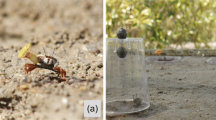Abstract
Non-independent mate selection occurs when the choice behavior of a female is altered by the interactions between other females and males. In the fiddler crab Uca mjoebergi, males court mate-searching females by waving their one greatly enlarged claw. When a female approaches a male, he initiates high-intensity waving. We conducted one natural mate choice experiment and two mate choice experiments using custom-built robotic crabs. We show that the decision of one female to approach a group of males increases the probability that another female will approach and visit a male from the same group. We suggest that this behavior is best explained by the ‘stimulus enhancement’ hypothesis, where the presence of a female near a group of males makes them more likely to be detected by other females due to an increase in male display rate.


Similar content being viewed by others
References
Andersson M (1994) Sexual selection. Princeton University Press, New Jersey
Backwell PRY, Jennions MD, Passmore NI, Christy JH (1998) Synchronized courtship in fiddler crabs. Nature 391:31–32
Backwell PRY, Jennions MD, Passmore NI, Christy JH (1999) Female choice in the synchronously waving fiddler crab, Uca annulipes. J Ethol 105:415–422
Booksmythe I, Detto T, Backwell PRY (2008) Female fiddler crabs settle for less: the travel costs of mate choice. Anim Behav 76:1775–1781
Briggs SE, Godin J-GJ, Dugatkin LA (1996) Mate-choice copying under predation risk in the Trinidadian guppy (Poecilia reticulata). Behav Ecol 7:151–157
Brown GR, Fawcett TW (2005) Sexual selection: copycat mating in birds. Curr Biol 15:R626–R628
Brooks R (1996) Copying and the repeatability of mate choice. Behav Ecol Sociobiol 39:323–329
Brooks R (1999) Mate choice copying in guppies: females avoid the place where they saw courtship. Behaviour 136:411–421
Dugatkin LA (1992) Sexual selection and imitation: females copy the mate choice of others. Am Nat 139:1348–1389
Dugatkin LA, Godin J-GL (1992) Reversal of female mate choice by copying. Proc R Soc Lond B 249:179–184
Fayed SA, Jennions MD, Backwell PRY (2008) What factors contribute to the ownership advantage? Biol Letters 4:143–145
Gibson RM, Höglund J (1992) Copying and sexual selection. TREE 7:229–232
Godin J-GJ, Herdman ELE, Dugatkin LA (2005) Social influences on female mate choice in the guppy, Poecilia reticulata: generalized and repeatable trait-copying behaviour. Anim Behav 69:999–1005
LaFleur DL, Lozano GA, Sclafani M (1997) Female mate-choice copying in guppies, Poecilia reticulata: a re-evaluation. Anim Behav 54:579–586
Mery F, Varela SAM, Danchin E, Blanchet S, Pareo D, Coolen I, Wagner RH (2009) Public versus personal information for mate copying in an invertebrate. Curr Biol 19:730–734
Milner RNC, Jennions MD, Backwell PRY (2008) Does the environmental context of a signalling male influence his attractiveness? Anim Behav 76:1565–1570
Milner RNC, Jennions MD, Backwell PRY (2010a) Eavesdropping in crabs: an agency for lady detection. Biol Letters 6:755–757
Milner RNC, Detto T, Jennions MD, Backwell PRY (2010b) Experimental evidence for a seasonal shift in the strength of a female mating preference. Behav Ecol 21:311–316
Matsumasa M, Murai M (2005) Changes in blood glucose and lactate levels of male fiddler crabs: effects of aggression and claw waving. Anim Behav 69:569–577
Reading KL, Backwell PRY (2007) Can beggars be choosers? Male mate choice in a fiddler crab. Anim Behav 74:867–872
Reaney LT, Backwell PRY (2007) Temporal constraints and female preference for burrow width in the fiddler crab, Uca mjoebergi. Behav Ecol Sociobiol 61:1515–1521
Reaney LT, Sims RA, Sims SWM, Jennions MD, Backwell PRY (2008) Experiments with robots explain synchronized courtship in fiddler crabs. Curr Biol 18:R62–R63
Vukomanovic J, Rodd FH (2007) Size dependent female mate copying in the guppy (Poecilia reticulata): large females are role models but small ones are not. J Ethol 113:579–586
Witte K, Massmann R (2003) Female sailfin mollies, Poecilia latipinna, remember males and copy the choice of others after 1 day. Anim Behav 65:1151–1159
Westneat DF, Walters A, McCarthy TM, Hatch MI, Hein WK (2000) Alternative mechanisms of nonindependent mate choice. Anim Behav 59:467–476
Yorzinski JL, Platt ML (2010) Same-sex gaze attraction influences mate-choice copying in humans. PLoS ONE 5:e9115
Acknowledgments
We thank Isobel Booksmythe and two anonymous reviewers for helpful comments on the manuscript. Research was funded by the Animal Behavior Society (to R.N.C.M.), an Australian Postgraduate Award (to R.N.C.M.) and the Australian Research Council (to P.R.Y.B. and M.D.J.).
Author information
Authors and Affiliations
Corresponding author
Additional information
Communicated by C. Gabor
Rights and permissions
About this article
Cite this article
Milner, R.N.C., Jennions, M.D. & Backwell, P.R.Y. Non-independent mate choice in a fiddler crab: a case of stimulus enhancement. Behav Ecol Sociobiol 65, 1419–1424 (2011). https://doi.org/10.1007/s00265-011-1152-z
Received:
Revised:
Accepted:
Published:
Issue Date:
DOI: https://doi.org/10.1007/s00265-011-1152-z




